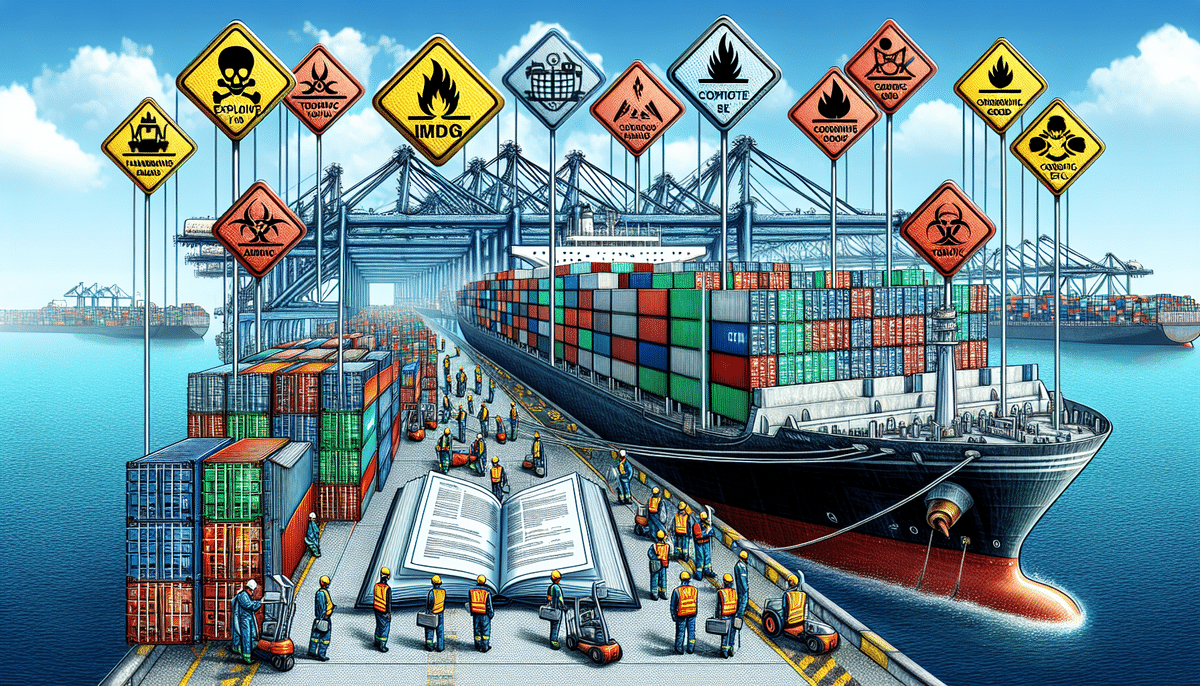Understanding IMDG: An Introduction to International Maritime Dangerous Goods
International Maritime Dangerous Goods (IMDG) is a set of global regulations for the transportation of hazardous materials by sea. These regulations were established to ensure the safe transportation of dangerous goods, minimize the risk of accidents, and protect the environment. IMDG compliance is mandatory for all shippers and carriers who intend to transport dangerous goods by sea. In this article, we will provide a comprehensive overview of IMDG, its importance, different classes of dangerous goods, compliance and safety requirements, and much more. Read on to learn all you need to know about IMDG.
Why IMDG is Important for the Global Shipping Industry
With the increase in international trade, the transportation of dangerous goods by sea has become more frequent. This highlights the importance of implementing a set of regulations that promote the safe transportation of hazardous materials. IMDG ensures that the safety of the people involved in the shipping industry, as well as the environment, is protected by providing guidelines for the handling of dangerous goods. Compliance with IMDG is a requirement for all those who wish to transport dangerous goods by sea, and failure to comply can result in severe penalties.
IMDG also plays a crucial role in facilitating international trade by providing a standardized system for the classification and labeling of dangerous goods. This ensures that all parties involved in the transportation of hazardous materials are using the same terminology and safety measures, reducing the risk of accidents and delays in the supply chain.
Furthermore, IMDG is regularly updated to reflect new developments in the shipping industry and changes in the types of dangerous goods being transported. This ensures that the regulations remain relevant and effective in promoting the safe transportation of hazardous materials. As such, IMDG is an essential tool for the global shipping industry, helping to ensure the safe and efficient transportation of goods by sea.
The History and Evolution of IMDG Regulations
IMDG regulations have existed since 1965, and several amendments have been made since then. The objective of these regulations has always been to improve the safety of marine transportation of dangerous goods while facilitating international trade. The IMDG Code is updated biennially to ensure that the regulations remain current and effective in addressing new developments and advancements in the transportation industry.
One of the major changes in the IMDG regulations was the introduction of the International Maritime Dangerous Goods (IMDG) Code in 1985. This code standardized the classification, packaging, labeling, and documentation of dangerous goods for transportation by sea. It also established training requirements for personnel involved in the transportation of dangerous goods.
Another significant development in the evolution of IMDG regulations was the adoption of the United Nations Recommendations on the Transport of Dangerous Goods in 2003. This adoption ensured that the IMDG regulations were aligned with the global standards for the transportation of dangerous goods, making it easier for shippers to comply with regulations across different modes of transportation.
Different Classes of Dangerous Goods Under IMDG
The IMDG Code classifies dangerous goods into nine classes, based on their physical and chemical properties. These classes are:
- Explosives
- Gases
- Flammable liquids
- Flammable solids
- Oxidizing substances and organic peroxides
- Toxic and infectious substances
- Radioactive material
- Corrosive substances
- Miscellaneous dangerous substances and articles
Each class is further divided into subcategories, which are identified by a numerical code. For example, Class 3 includes flammable liquids with different flashpoints and boiling points, each assigned a specific code. This level of detail is crucial for proper handling, storage, and transportation of dangerous goods, as it ensures that the appropriate safety measures are taken based on the specific properties of the substance.
IMDG Compliance and Safety Requirements for Shippers and Carriers
IMDG compliance and safety requirements are stringent. Shippers and carriers have to ensure that hazardous materials are correctly classified, packed, marked, and labeled before being transported by sea. They have to follow specific requirements related to documentation, training and certification, segregation, stowage, and handling. Failure to adhere to these regulations can result in significant penalties, including fines, imprisonment, and even the revocation of a company’s license. Additionally, non-compliance can put the safety of the crew, shipping personnel, and the environment at risk.
It is important for shippers and carriers to stay up-to-date with the latest IMDG regulations and requirements. These regulations are constantly evolving to ensure the safe transportation of hazardous materials by sea. Shippers and carriers should regularly review their processes and procedures to ensure compliance with the latest regulations. They should also invest in ongoing training and education for their employees to ensure they are aware of the latest requirements and best practices for handling hazardous materials. By doing so, they can help to ensure the safety of their employees, the environment, and the communities in which they operate.
The Role of Packaging, Labeling, and Marking in IMDG Compliance
The packaging, labeling, and marking of dangerous goods must comply with IMDG regulations. The packaging must be durable, secure, and tested to ensure that it can withstand the rigors of sea transportation. It must also be compatible with the specific class and quantity of dangerous goods being shipped. Proper labeling and marking of the packages are essential to ensure that the crew, transporters, and regulatory authorities understand the nature of the hazardous materials being transported. IMDG regulations provide detailed guidelines on the labeling, marking, and packaging requirements, and these guidelines must be followed carefully.
In addition to the packaging, labeling, and marking requirements, IMDG regulations also require that shippers provide proper documentation for the dangerous goods being transported. This documentation includes a dangerous goods declaration, which provides information on the nature, quantity, and classification of the hazardous materials being shipped. The declaration must also include emergency response information, such as contact information for the shipper and emergency response procedures.
Another important aspect of IMDG compliance is the training of personnel involved in the transportation of dangerous goods. All personnel involved in the handling, packaging, labeling, and transport of hazardous materials must be trained in accordance with IMDG regulations. This training includes instruction on the proper handling and storage of dangerous goods, as well as emergency response procedures in the event of an incident.
IMDG Transport Documentation Requirements: Bills of Lading, Dangerous Goods Declarations, and More
IMDG regulations require a range of transport documents to be prepared and presented when shipping hazardous materials by sea. These documents provide critical information on the dangerous goods being transported, such as their classification, quantity, and mode of transport. One such document is the Dangerous Goods Declaration, which declares that the goods being transported comply with IMDG regulations. Another important document is the Bill of Lading, which serves as the contract of carriage between the shipper and the carrier.
In addition to the Dangerous Goods Declaration and Bill of Lading, other transport documents required by IMDG regulations may include the Container Packing Certificate, which verifies that the hazardous materials have been properly packed and secured within the container, and the Stowage Plan, which outlines the location of the hazardous materials on the vessel. It is important to ensure that all required transport documents are accurately completed and presented to the carrier, as failure to do so can result in delays, fines, and even safety hazards.
Training and Certification Requirements for IMDG Compliance
IMDG regulations require all personnel involved in the transportation of hazardous materials by sea to have specific training and certification. This includes shippers, carriers, and others responsible for the packing, marking, labeling, and documentation of dangerous goods. The training must encompass the IMDG regulations, as well as general safety practices in handling and transporting hazardous materials. Certification is achieved by passing an examination conducted by an accredited training provider.
It is important to note that the training and certification requirements for IMDG compliance are not optional. Failure to comply with these regulations can result in serious consequences, including fines, legal action, and even the revocation of a company’s license to transport hazardous materials. Additionally, regular refresher training is required to ensure that personnel stay up-to-date with any changes or updates to the IMDG regulations.
Common Challenges and Pitfalls in IMDG Compliance
IMDG compliance is a complex undertaking that requires careful attention to detail. Common pitfalls in compliance include incorrect classification of hazardous materials, improper packaging, labeling, and marking, inadequate or incorrect documentation, and insufficient or inappropriate training. It is critical to work with knowledgeable and experienced professionals to avoid these common mistakes and ensure total compliance.
Best Practices for Safe Handling, Storage, and Transportation of Dangerous Goods Under IMDG
IMDG compliance is a crucial aspect of transporting hazardous materials by sea, but it is not sufficient on its own. It is essential to follow best practices for the safe handling, storage, and transportation of dangerous goods. This includes ensuring that personnel involved in the shipping process are adequately trained and certified, using appropriate packaging, labeling, and marking, and adhering to requirements for segregation and stowage of dangerous goods.
How to Prepare for an IMDG Audit or Inspection by Regulatory Authorities
Preparation is key to a successful IMDG audit or inspection. The best approach is to be proactive and ensure that all IMDG regulations are followed to the letter. All personnel involved in the shipping process must be fully trained and certified, and all documentation must be up to date and complete. Additionally, having a comprehensive understanding of the IMDG Code and its requirements can help organizations prepare for an audit or inspection and ensure that their operations are fully compliant.
Recent Updates and Amendments to the IMDG Code: What You Need to Know as a Shipper or Carrier
The IMDG Code is updated every two years to address any new developments or advancements in the shipping industry. Recent updates and amendments to the code have included guidelines for the transportation of lithium batteries and amendments related to the classification of corrosive substances. It is essential for shippers and carriers to stay up to date on these changes and ensure that their operations comply with the latest IMDG regulations.
Understanding the Liability Implications of Non-Compliance with IMDG Regulations
Non-compliance with IMDG regulations can have severe liability implications, including fines, imprisonment, and legal action. In addition, non-compliance can also result in damage to the environment, injury to personnel, and other harmful consequences. It is essential for organizations involved in the shipping industry to take IMDG compliance seriously and ensure that they adhere to all applicable regulations.
Expert Tips and Advice on Navigating the Complexities of IMDG Compliance
IMDG compliance is a complex undertaking, and it is often challenging for shippers and carriers to navigate the various regulations and requirements. Working with experienced professionals can be invaluable in helping organizations ensure total compliance. Seeking expert advice, training, and guidance can help organizations avoid common pitfalls and ensure that they meet all IMDG regulations.






















